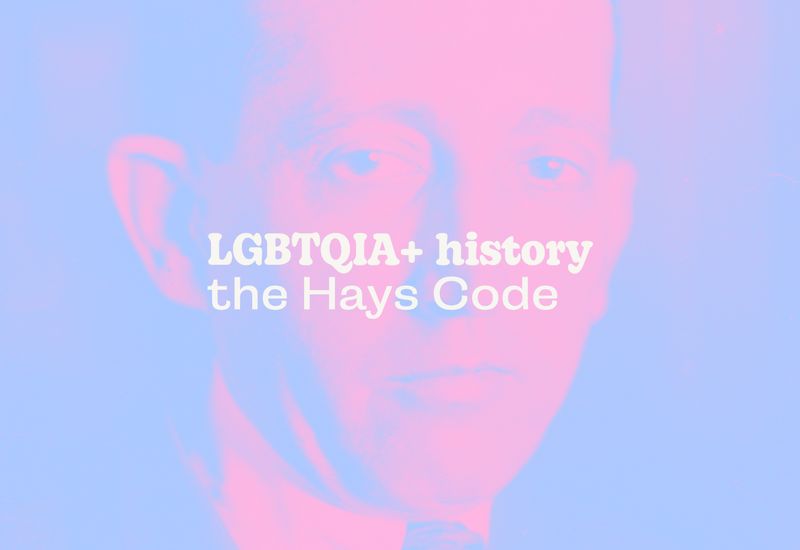For a large portion of the 20th century, depictions of many things in film - including gay interactions - were prohibited.
Cinema wasn’t always as free as it is today. Early Hollywood was rife with scandals and states were thinking about bringing in film censorship laws. There were boards for regulating film content, but little was done until 1930, when a new code was adopted.
What is the Hays Code?
William Harrison Hays Sr. was the first president of the MPPDA (Motion Picture Producers and Distributors of America, now known as the MPA). He oversaw the introduction of the Production Code, a set of rules that filmmakers had to follow. It started first as a formula. It then became a list of “Don’ts and Be Carefuls”, the former of which are listed below:
- Pointed profanity—by either title or lip—this includes the words God, Lord, Jesus, Christ (unless they be used reverently in connection with proper religious ceremonies), Hell, S.O.B., damn, Gawd, and every other profane and vulgar expression however it may be spelled;
- Any licentious or suggestive nudity—in fact or in silhouette; and any lecherous or licentious notice thereof by other characters in the picture;
- The illegal traffic in drugs;
- Any inference of sex perversion;
- White slavery;
- Miscegenation;
- Sex hygiene and venereal diseases;
- Scenes of actual childbirth—in fact or in silhouette;
- Children's sex organs;
- Ridicule of the clergy;
- Willful offense to any nation, race or creed.
Depicting homosexuality was by default assumed to be included in the “sex perversion” category.
Once this was approved by the heads of film studios at the time, and in collaboration with Catholic publisher Martin Quigley, the code was accepted by the MPPDA. The code itself was split into two parts: general principles and particular applications. Basically, it was a way of censoring film to reflect the views of the time.
What was the impact of the Hays Code?
From 1934, films had to have the approval of the Production Code in order to be released. And, for a good few decades, most of them did. There would often be scenes shortened or cut entirely from the release version. If you wanted your film to be seen by anyone, you’d do what Joseph Breen (head of the Production Code Administration) deemed.
This often meant that certain people just couldn’t be portrayed openly. Gay characters still existed, just not explicitly. Effeminate men with no wife were the only representation possible at the time. Lesbians and trans people didn’t even get this much. This is a phenomenon known as queer coding. Even after the code dissipated, this trope lingered.
With “miscegenation” or race-mixing also banned, this meant many talented actors of colour were sidelined to supporting roles. This is also a large factor in why there are many black, brown, and yellowface performances in the 50s and 60s.
When did the Hays Code stop?
To be honest, it started fizzling out in the 50s with the rise of TV providing a new competitor. Mix this with the Supreme Court ruling that owning the supply chain violates antitrust laws. Studios no longer had ownership of the theatres and were facing losses at the hands of at-home entertainment and foreign films which were not bound by the code.
With the death of Eric Johnston in 1963, a new president – Jack Valenti – was appointed by the more liberal faction of the association. Valenti strongly opposed the code. The same year, “Who’s Afraid of Virginia Woolf?” was the first film to feature a “Suggested for Mature Audiences” label.
Two years later, the MPA film rating system went into effect, with the ratings G, M, R and X. These eventually evolved into the ratings used today: G, PG, PG-13, R and NC-17. It was less about censoring the films outright but more about indicating the appropriate audience for the film.
Do we still feel these effects today?
Positive portrayals of homosexuality were expressly banned, leaving only space for comedic or villainous gays. This created a trope: the queer-coded villain. While the LGBTQIA+ community today does find some level of relatability to them, it wasn’t great growing up only seeing yourself as either a punchline or antagonist.
Another way filmmakers dealt with the “no positive portrayals'' rule was by giving any POC or LGBTQ+ characters a sad ending. “Kill your queers” is yet another trope brought about as a result of the Production Code.
The “black best friend” trope is also believed to originate from the Hays era, as a result of black actors only being cast in supporting roles.
Prospective student? We want to hear from you! Join the Student Hut Forum and earn £s by taking surveys.













